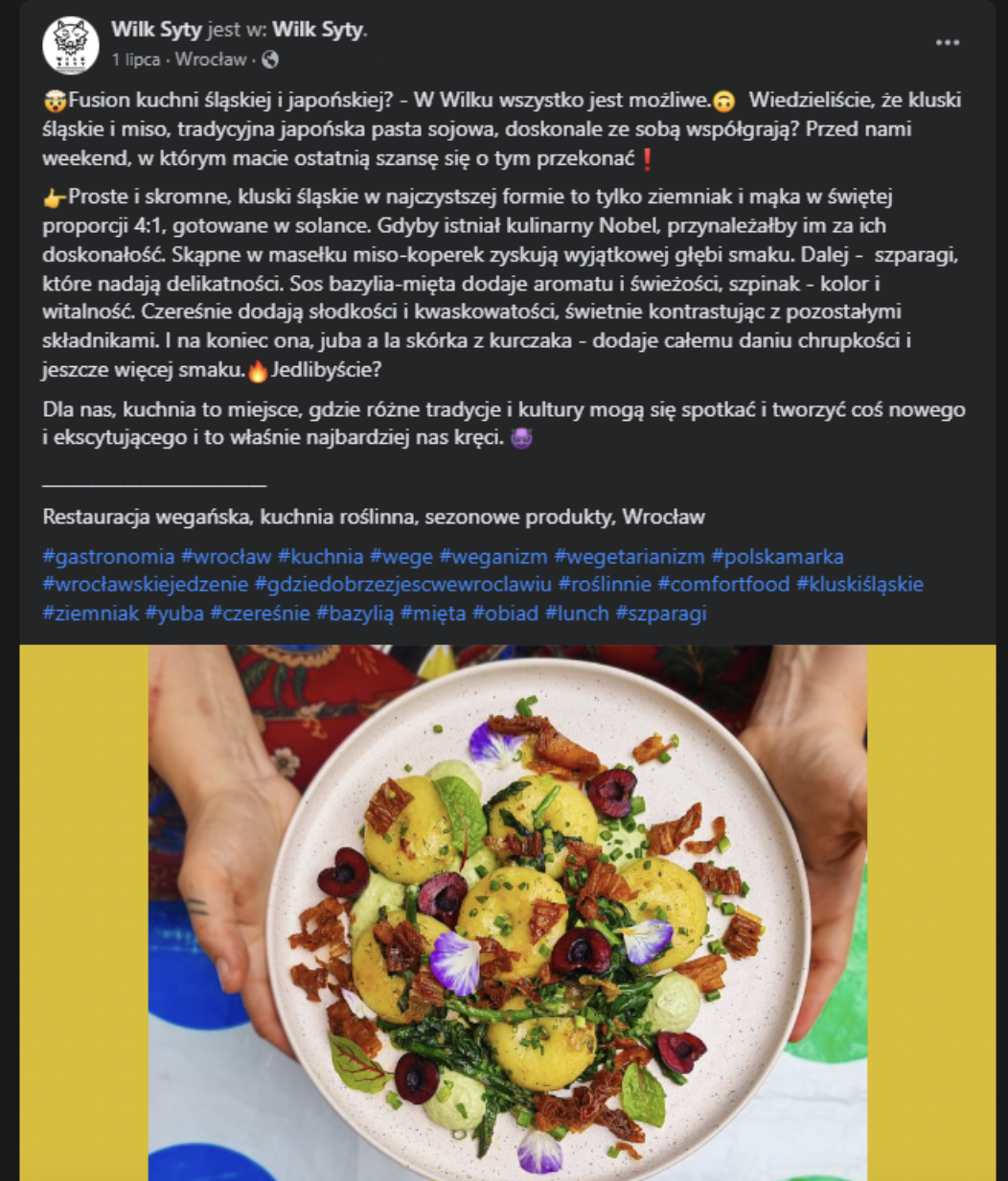Copywriting to sztuka opowiadania historii. Nie jest to po prostu „gadanie”, a technika, która skutecznie użyta, potrafi zdziałać cuda. Dzisiaj zapraszam Cię do podróży, podczas której poznasz przepis na udany copywriting.
Każda marka, niezależnie od tego, z jakiej branży się wywodzi, ma swoją grupę docelową, a przynajmniej mieć powinna. Musisz pamiętać, że nie istnieje target „wszyscy”. Kiedyś mawiano, że jeśli coś jest do wszystkiego, jest do niczego. Podobnie jest z firmami – te stworzone dla każdego, są tak naprawdę dla nikogo. Zatem jak tworzyć copywriting, który posmakuje Twoim odbiorcom?
Pisząc teksty na stronę www, social media, tworząc menu, czy nawet proste zaproszenia na wieczór degustacyjny, musisz pamiętać o jednym – kim jest osoba do której piszesz. Jest to kluczowe, ponieważ każdy czytelnik ma swoje nawyki. Zanim zaczniesz tworzyć copy, sprawdź, jakich słów-kluczy używają Twoi odbiorcy. Jakim językiem się posługują: czy jest on formalny? Może luźny i spontaniczny? Być może używają jakiegoś slangu? Ta wiedza jest Twoją podstawą do przygotowania iście wybornego dania.
Synchronizacja…mózgów i smaków!
Zdarzyło Ci się płakać na filmie? Albo zdenerwować po wysłuchaniu historii swojej rozżalonej przyjaciółki? Może skakałeś/aś z radości, gdy Twoje dziecko opowiadało o wygranych zawodach? To wszystko nie działo się przypadkowo.
Profesor Uri Hasson to neurobiolog i badacz komunikacji z Uniwersytetu Princeton. Wykazał, że mózg osoby słuchającej jakiejś historii synchronizuje się z mózgiem osoby opowiadającej. Aktywują się w nich wówczas te same ośrodki. Ten efekt to synchronizacja neuronalna. Dzieję się tak tylko wtedy, gdy mamy do czynienia ze spójną, poruszającą i zrozumiałą historią. Kluczem jest więc treść, a nie słowa same w sobie.
Przypuśćmy, że ktoś opowiada historię o tym, że zjadł bardzo kwaśną cytrynę. Od razu nasze ślinianki wskakują na drugi bieg, a twarz się wykrzywia. Inaczej też zareagujemy na komunikat „Zjadłem rano kanapkę”, a inaczej na opowieść „Do porannej, aromatycznej czarnej kawy zjadłem grubą kromkę wiejskiego chleba ze świeżym masłem i szczyptą soli”. Widzisz różnicę? Twoi goście również ją widzą.
Nie kombinuj! Za dużo przypraw wprowadza chaos.
Kiedy dodasz do potrawy zbyt wiele przypraw, staje się ona ciężkostrawna i niezjadliwa. Podobnie jest z historiami. By uniknąć problemów trawiennych, użyj prostej zasady, która ukrywa się w angielskim akronimie SUCCES. To prosta droga do sukcesu!
Simple – historia musi być prosta!
Nie ma nic gorszego niż gawędziarz, który skacze z wątku na wątek. Chyba każdy z nas zna kogoś takiego i spotkania z nim nie należą do łatwych. Nie wiadomo jaki jest sens wypowiadanych przez niego słów. Pamiętaj – prosta historia nie równa się historii prostackiej! Aby iść w myśl tej zasady, unikaj wielopoziomowych dygresji i zbyt wielu szczegółów w jednej opowieści. Staraj się używać konkretnych określeń: co, kto, gdzie, kiedy, jak. Najsłynniejsze historie porwały ludzi, bo były proste do zapamiętania i przekazania dalej.
Unexpected – zaskocz mnie!
Serwuj swoim odbiorcom jak na talerzu zagadki i to, czego się nie spodziewają. Dlaczego? Jeśli mózg słyszy tylko to, czego się spodziewa, w końcu przestaje słuchać. Opowieści tendencyjne i takie, w których wiemy, co się wydarzy, po prostu nas nudzą i nie skupiamy na nich uwagi. Zobacz w jakich sposób uwagę swoich gości przyciągnął wrocławski Wilk Syty.

źródło: Facebook
Credible – opowiadaj wiarygodne historie.
Spójność to klucz do wiarygodności. Ale to nie wszystko. Wiarygodność historii zależy również od tego, kto nam ją przekazuje. Bardziej ufamy osobom, które są nam bliskie, wyznają podobne do naszych wartości oraz osoby, które po prostu lubimy. Niezwykle istotny jest sposób przekazania opowieści. Ważny jest prosty język, chronologia, logika zdarzeń oraz łatwość poznawcza. Pamiętaj, że nasz mózg uznaje za prawdziwe te treści, które są łatwe do przetworzenia.
Concrete – konkrety poproszę!
Opowiadając historię, buduj konkretne obrazy, które mózg odbiorcy może sobie wyobrazić. Na przykład: Gdy Twoja opowieść toczy się w Egipcie, użyj słowa „piramidy” zamiast „bardzo stare budowle”. Lepiej też brzmi „kromka chleba z masłem” niż „wyrób piekarniczy z nabiałem”.
Emotional – wzbudź we mnie jakieś emocje!
Nie ma emocji – nie ma uwagi. To one powodują, że nie nudzimy się opowieścią. Różne emocje będą inaczej modelować zachowanie odbiorcy. Na przykład smutek zazwyczaj sprawia, że słuchacze są hojniejsi. Uczucie radości budzi chęć podzielenia się jej powodem. Gniew bardzo silnie radykalizuje, a wzruszenie budzi sentyment i sprawia, że odbiorcy pomyślą lepiej o sobie samych. Dlatego budując opowieść, zastanów się, jaką reakcję chcesz wywołać u swojego odbiorcy.
Sequential – pamiętaj o sekwencjach.
Ostatnia szczypta (do) sukcesu – pamiętaj, aby wydarzenia w Twojej historii układały się w logiczną całość. Jest to konieczne, aby mózg odbiorcy Ci uwierzył. Jeśli wiemy i rozumiemy, co z czego wynika, łatwiej temu wierzymy. Oczywiście nie chodzi o to, abyś nie wprowadzał/a dygresji do swoich historii, ale niech nie zaburzy ona ciągu całej akcji.
Jak widzisz, przepis na udany tekst jest bardzo prosty! W copywritingu jest jak w kuchni – pamiętaj, kto jest Twoim gościem, dodaj porządną szczyptę emocji i ciesz się smakiem! Jeśli chcesz spróbować więcej, zapraszam Cię do przeczytania artykułu Tekst ma znaczenie. Jak opowiadać angażujące historie?










 Młodszy specjalista ds. komunikacji marketingowej i PR.
Młodszy specjalista ds. komunikacji marketingowej i PR.


 Absolwent Uniwersytetu Warszawskiego oraz Szkoły Głównej Gospodarstwa Wiejskiego. W branży HoReCa od ponad 10 lat. Przez lata związany z Grupą Trip, Sobienie Królewskie Golf and Country Club oraz restauracją Florentin w Warszawe.
Absolwent Uniwersytetu Warszawskiego oraz Szkoły Głównej Gospodarstwa Wiejskiego. W branży HoReCa od ponad 10 lat. Przez lata związany z Grupą Trip, Sobienie Królewskie Golf and Country Club oraz restauracją Florentin w Warszawe. Absolwentka Wydziału Architektury Politechniki Warszawskiej na kierunku Architecture for Society of Knowledge oraz Komunikacji Wizualnej na Politecnico di Milano. Specjalistka od budowania nastroju. Doświadczenie zdobywała w kraju i zagranicą podczas licznych warsztatów międzynarodowych (Sevilla, Lizbona, Florencja), stypendium na La Sapienza (Rzym) oraz pracując m.in. w Carmi e Ubertis i ADM Milano.
Absolwentka Wydziału Architektury Politechniki Warszawskiej na kierunku Architecture for Society of Knowledge oraz Komunikacji Wizualnej na Politecnico di Milano. Specjalistka od budowania nastroju. Doświadczenie zdobywała w kraju i zagranicą podczas licznych warsztatów międzynarodowych (Sevilla, Lizbona, Florencja), stypendium na La Sapienza (Rzym) oraz pracując m.in. w Carmi e Ubertis i ADM Milano.








 Menedżer z wieloletnim doświadczeniem w branżach kosmetycznej, spożywczej, dziecięcej. W trakcie swojej kariery związany z firmami takimi jak: L’Oreal, Samsung, Danone-Nutricia, Unilever. W ciągu swojego życia zawodowego odpowiadał między innymi za rozwój sprzedaży i contentu eCommerce w Polsce i krajach Europy Środkowo-Wschodniej.
Menedżer z wieloletnim doświadczeniem w branżach kosmetycznej, spożywczej, dziecięcej. W trakcie swojej kariery związany z firmami takimi jak: L’Oreal, Samsung, Danone-Nutricia, Unilever. W ciągu swojego życia zawodowego odpowiadał między innymi za rozwój sprzedaży i contentu eCommerce w Polsce i krajach Europy Środkowo-Wschodniej. 

























































